All about growing eggplant

Eggplant or "blue" is a favorite product for many of us. They make excellent snacks that are equally good fried, baked, stewed and marinated. In addition to being tasty and nutritious, vegetables are also very healthy. But the popular vegetable crop is sensitive to negative factors. Therefore, many gardeners are puzzled by the question of how to grow a good eggplant crop.
The necessary conditions
First of all, you need to choose a suitable place for the growth of eggplants. Grow them correctly in a well-lit garden. "Blue" need to be protected from the northern winds, so it will be very practical if the planting is protected from blowing by a fence or a wall of the building.
For the growth of heat-loving eggplants, the following air temperature is optimal:
- daytime - + 25-28 ° C;
- night - from + 16 ° C.
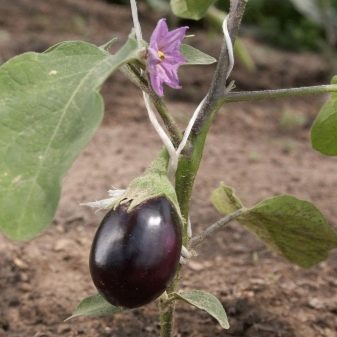

At such temperature indicators, plants grow and develop correctly, bloom in a timely manner and set fruits. If the air temperature drops below + 15 ° C, a slowdown in their growth is noted, flowers and ovaries fall off. An increase in temperature above + 34 ° C also negatively affects eggplants. In such a heat, flowers fall, the fruits become smaller, the skin on them becomes tougher. If the soil in the greenhouse or on the beds is not warmed up or cooled below + 17 ° C, the plants slow down their growth, and the flowers and ovaries that appear will fall off. Eggplants also need a lot of sunlight to maintain normal vegetation, flowering and fruiting. The plant also has high moisture requirements. The plant especially needs it during the period of setting and growing vegetables. The optimum soil moisture is considered to be 75%, for the period of maximum demand, this figure rises to 80–85%.
Eggplants react very sharply and rapidly to changes in the air and water regime of the soil. If the water supply is irregular, flowers and ovaries will quickly fall off. Insufficient watering during the fruiting period provokes the development of dry apical rot on fruits. Physiological calcium deficiency in fruits contributes to this disease. This microelement is supplied to plants by water from the substrate, penetrating into their fastest growing parts. Subsequently, this element cannot move inside the plant, for example, from leaves to organs, where it is in short supply, that is, to fruits.
Eggplants are very sensitive to an increase in air humidity, which contributes to the development of more harmful diseases. Infection with gray rot is especially dangerous for the plant. When the humidity rises, pollination of flowers is also difficult. Low humidity (less than 50%) is also an unsuitable level, since this increases the transpiration of plants, and the flowers that appear fall off pollinated, as the pollen grains and pistils dry out quickly. Eggplants are quite demanding on the substrate. The best option is considered to be planting in a warm substrate saturated with organic matter and minerals, with a low acidity level (6.0-6.6 pH).
Greenhouse eggplants require breathable and permeable soil.

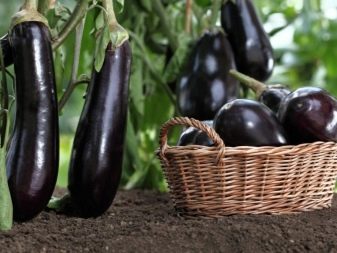
Landing dates
Eggplants are transplanted into open ground at different times, depending on where they are grown. In the Moscow region and the middle lane, a vegetable crop can be planted in the ground, starting from May 15. Freshly planted plants are covered with white agrofibre. It is advisable to choose a canvas with a density of 17-23 g / m2. Plants are kept in shelter until the end of May.Tall plants can be planted around the garden plot, for example, in the south it can be a wide strip of wheat on one side, and on the other - strips of sweet corn.
Certain plants are suitable for planting. They should be the same height (about 30 cm), with 6-8 true leaves on a stem 5-8 mm thick at the root collar. Before transplanting plants to a permanent place, it is important to harden them. A suitable hardening method is limited watering 4-6 days before the scheduled planting date. Seedlings are taken outside in warm weather during the daytime "for a walk". Gradually, the amount of time spent on the street increases.
The planting pattern for eggplants differs depending on where they are planted and what growing and care methods will be applied:
- 2-3 plants are planted per 1 m2 in greenhouses;
- in the open field, the eggplant planting scheme is as follows - 30x80 cm.
In unheated film greenhouses made of polycarbonate, eggplants are most often grown on a garden substrate. This requires careful preparation, including saturation with organic matter in the fall.

How to plant?
In domestic climatic conditions, this vegetable crop is grown exclusively from seedlings. Seedlings can be grown both at home and in heated greenhouses. Planting eggplant seeds in open ground can only be carried out in warm climates. Eggplants from seedlings are grown by sowing seeds from late winter to spring (January to March). Depending on the region, the optimal date for planting seedlings in an unheated greenhouse under a film or in a tunnel is mid to late May. Seedling soil can be prepared from garden soil by adding peat and sand to it (25% each of the total soil composition). You can sow eggplant seeds in peat tablets.
Since seeds take a long time to germinate, they must be germinated before planting. The optimum temperature for germination is + 25 °. The process of preparing eggplant seeds also includes such a procedure as soaking, which accelerates the germination of the seed. In parallel with soaking, it is recommended to do disinfectant etching. This will protect the seeds from disease. Seeds are sown with further picking or directly into separate cups. If a subsequent pick is expected, plant growth is delayed by 1-1.5 weeks. Therefore, more often the seeds are planted immediately in separate glasses or peat tablets. In wooden or plastic boxes filled with soil, seeds are sown in pre-cut shallow grooves. They are arranged in rows, maintaining a distance of 1.0-1.5 cm.
Then sprinkle with river sand (no more than 0.5 cm), irrigate the sand layer with water from a spray bottle and cover with perforated film. A nonwoven fabric can be used for this purpose. This will prevent the substrate from drying out. When sowing vegetable seeds in peat tablets, the seed is buried 1 cm in the ground. Each tablet contains 1 seed, but you can also plant 2 seeds. If both sprout, after opening the cotyledons, divide the tablet.
A high temperature is maintained in the seed box during the germination period:
- 24-28 ° C - sprouts appear on the 5-8th day;
- 20-22 ° C - after 2 weeks.
Seedlings are grown in boxes in a greenhouse, and tablets and cups are placed on a balcony, a heated loggia or just in a house on a windowsill.
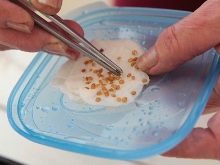
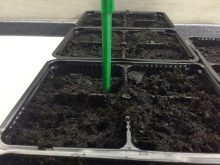
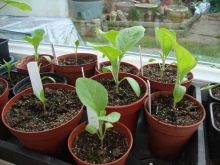
Care
Experienced farmers have their own secrets of how to grow a high-quality crop of excellent fruits. At each separate stage, it is important to adhere to certain rules. Then anyone who wishes will get delicious eggplants.
Watering
Eggplant is a moisture-loving culture. How the plants grow and develop, the quality and quantity of the crop depend on well-organized watering. Water the plantings only with warm water. In the south, it is convenient to heat water in buckets, exposing them to the sun. In other regions, water is heated artificially up to + 25 ° C.This is the optimum temperature for watering the eggplant.
Eggplants should not be watered from above, water is poured under the root. If a vegetable crop is grown by the seedling method, it is watered for the first time 10-12 days after planting. In the heat - for 7-8 days. The soil should always remain moist. But the humidity level should not exceed 70%. The roots of this plant do not tolerate high soil moisture. When the eggplant enters the phase of flowering and fruit setting, watering is done more abundantly and more often, up to 20 cm in depth. Plantings are watered every 5-6 days.

Loosening
In the garden, the soil should always remain loosened and moist. The appearance of a crust and the growth of weeds is unacceptable. The soil is loosened carefully, on the second day after irrigation.
At the same time, it is necessary to huddle the plants, raking the soil to the stems.

Fertilizer
With full-fledged agricultural technology, eggplants actively bear fruit. It is possible to remove from 3-7 kg from each bush, depending on the variety. But a good harvest is possible only with feeding once every 2-3 weeks. The first feeding is performed at the root. It is carried out 10 days after transplanting seedlings into the ground. With the appearance of the first new leaf on the bush, it is time to apply nitrogen-containing fertilizer. For this purpose, you can use "Kemira", "Crystallin", "Solution" or "Effecton". You only need 40 g of funds for a bucket of water. Normally, 1-1.5 liters of solution is enough per plant. Ammophoska solution is also suitable as fertilizer.
The second feeding is planned two weeks after the previous one. Now wood ash with nitroammophos is introduced at the rate of 20-25 g for each bush. Alternatively, you can use an extractor from poultry droppings. It will take 2-3 kg of droppings, infused for 2-3 days in a bucket of water. Then the infusion is filtered and diluted in 10-15 liters of warm water. One bush needs 1-1.5 liters of such a solution. The third feeding is carried out in the flowering phase of plants. Eggplants are fed with nitrophos or diammophos (40 g per 1 sq. M). It's time to spray the plants with preparations with trace elements or boric acid.
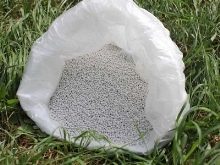
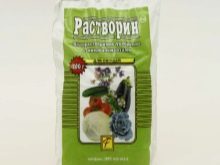
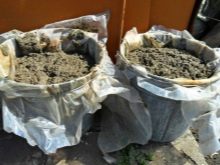
Garter
When planting, it is worthwhile to immediately provide pegs if the variety requires a subsequent garter. Newly planted plants, most likely, do not need a garter, but when they take root in the garden, they will continue to grow actively.
Outdoors, a garter is rarely required. Eggplant forms a fairly strong bush, holds the stems with fruits well, with the exception of certain varieties that need to be tied up.
Often it is enough just to lay a layer of mulch under the bush, and make support as needed.
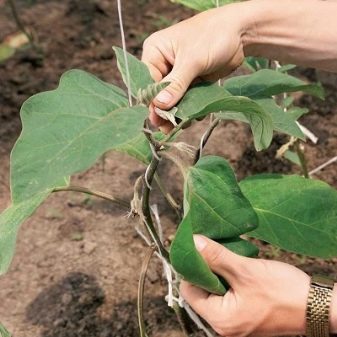
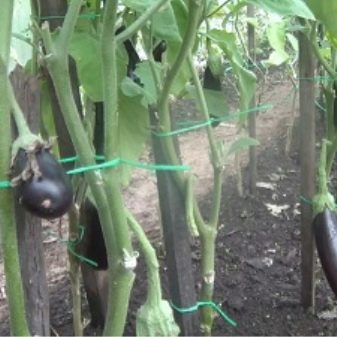
Formation
The methods of forming an eggplant bush differ depending on the growing conditions.
- In an unheated greenhouse, it is necessary to form vegetable crops by appropriate pruning, bringing them to the required number of directing shoots. Plants with 3-4 main shoots achieve good yields.
- In heated greenhouses, where the growing period is longer, a more radical formation is assumed - by 2-3 or even 1 directing shoot.
- When growing vegetables under a film, when the end of fruiting is determined by external temperature conditions, the preferred method of accelerating fruit growth is a one-time manual removal of the tops on the shoots. Above, above the tallest flower, only 2 leaves are left.
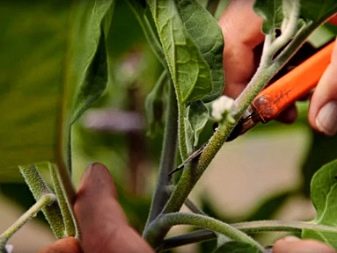
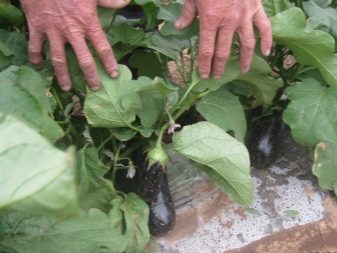
Diseases and pests
The causes of eggplant diseases are usually as follows.
- Lack of light.
- Moisture deficiency or waterlogging.
- Nutritional deficiency. Acidic soil can be improved by adding wood ash or dolomite flour. Alkaline soil will be enriched by the introduction of peat, moss, rotted needles or sawdust.
- Cold. Eggplant roots should be in warm soil. Because of the cold water, eggplants get sick with fungal infections, shed their ovaries and even die.
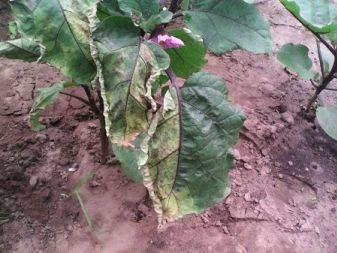
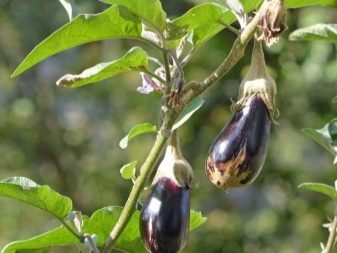
Eggplants can infect pathogenic bacteria, viruses, fungus. Treatment is selected based on the nature and type of disease.
- Blackleg. An insidious disease mainly affects seedlings (especially dived ones), but can also occur in adult crops. It can be recognized if the plant turns black at the bottom of the stem. Seedlings wither, and if left untreated, they die. The disease is not cured.
- Powdery mildew. It manifests itself as a white bloom on the outside of the leaf plates. They gradually dry up and the plants wither. If the leaves turn white, spraying the plants with Topaz or colloidal sulfur helps.
- Black spot. Like black leg, it is a very dangerous disease. Typically, the disease occurs when humidity is 85-90% during any growing season. If small black spots, framed by a yellow border, appear on the leaves, there is little time before the ulcers appear. It is necessary to act and reanimate the plants by processing "Fitoflavin" or "Gamair".
- Yellowness of the leaves. As a rule, this is a consequence of a violation of agricultural technology or diseases. This problem is solved by creating the right conditions and providing plants with fertilizing.
- Phytoplasmosis. This viral disease is also called stolbur. Most often it affects eggplants in the open field. But it is also found in greenhouses. The virus is carried by cicadas. The leaves become smaller, the green plates become purple or white. The fruits grow small and tough. Shown is the use of "Actellik" in the removal of all affected plants and soil disinfection.
- Phomopsis. A fungal disease that causes dry rot and death of the plant. The pathogen develops when the level of humidity and temperature rises, manifesting itself as light spots on the leaves. As the disease progresses, gray-brown spots appear on the fruits. They rot and gradually become covered with mucus.
- Cercosporosis. The fungus provokes the appearance of small yellow spots on the leaves and stalks. Leaves fall off, plants look lethargic and gradually die off. At the initial stage, spraying with Bordeaux liquid helps, and for more serious lesions, "Skor" or "Fundazol" is used.
- Gray and dry rot, verticillary wilting - all this can happen with eggplant if you neglect advice on planting care.
If brown or any other color spots appear on the sheets, you should act immediately. Perhaps the plant needs to be looked after differently, maybe it lacks something or an excess of moisture is allowed. Leaves in a small hole are a reason to check for parasites in the garden. The danger comes from aphids, slugs, bear, Colorado beetles. It is necessary to treat plants with Fitoverm. They love eggplants and Colorado beetles.
Plant care is important because prevention is easier than cure.
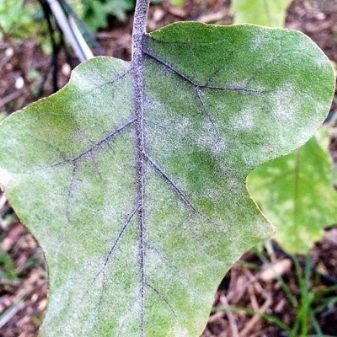
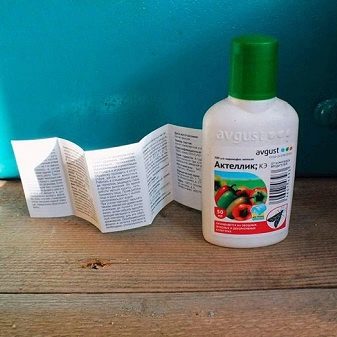













The comment was sent successfully.